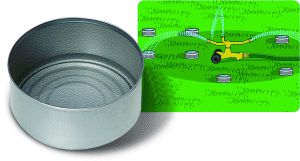One of our top questions is, “How much should I water my lawn?” The short answer is: Lawns need 1 inch of water per week to stay green. That is a combined total of rainwater and water from your sprinkler. The general rule of thumb is to water infrequently, but deeply.
If you are happy with that answer, you can supplement your knowledge with an article from the Seattle Times, “How much water is too much for your lawn?”
If you really want the lowdown on watering lawn grass, the answer is… “Well, it depends.” It depends on 1) grass type, 2) site conditions, 3) soil texture and structure, 4) evaporation and 5) root depth.
Let’s start by combining #1 and #5… grass type and root depth. In the Pacific Northwest, the primary grass seed mixes that we use consist of Ryes and Fescues. [See footnote 1 for drought-tolerant grass seed mixes]. These grass plants are very resilient and, if allowed to, can grow roots as deep as 14 feet! The problem is, most home builders scrape off good, native topsoil to build your home and then replace it with what they call “topsoil” - an inferior product applied only 2 - 4 inches deep. This “topsoil” is often placed over hard and compacted construction soils making it difficult to grow healthy turf with deep roots.
Here is a picture taken by one of our peers, Hendrikus Shraven, who is demonstrating how deeply grassroots can grow in the organic soil mixes that he prepares. He grew these 4½ feet roots in just 3 months! Imagine for a moment if your grassroots were this deep. Do you think you would need to water your lawn as frequently? Most likely not.

This brings us to #3… soil texture and structure, or, “What the heck am I growing my lawn on?” We could do an entire day seminar on this topic and still not cover all the bases. But suffice it to say, the amount of water your lawn needs is directly related to the soil under your lawn. Sandy soil drains water quickly. Clay soil holds water for long periods of time. Organic matter holds and releases water with great efficiency. The combination of sand, silt, clay, organic matter, and biological life (soil microorganisms) will affect how much water you need to put down.
And finally, we get to, 2) site conditions and 4) evaporation, or, “How much water is leaving the site before the plants can use it?” If your property is sloped, water will be lost as it rolls down the hill. If it is in full sunlight, the water will evaporate more quickly, especially during peak sunlight hours. Watering in the early morning hours when the sun is low and the wind is light will increase the amount of water that makes it into your soil.
What’s our biggest tip for reducing evaporation? Mow higher. Leave the grass blades at least 3 inches. Mowing higher helps to shade the soil keeping it cooler during the heat of the day. Mowing higher also increases photosynthesis, helping the grass perform better. Equally important, mulch mow your grass clippings. When you mow it off and haul it away you are removing a lot of energy from the system that created it. Mulch mowing adds back organic matter and nutrients for the grass, reducing the need to supplement as much with fertilizer. Plus, the mulched grass clippings add moisture-holding properties and help to keep the soil cooler reducing evaporation.
Okay, so you’re ready to give it a try, but you keep wondering, “How the heck do I measure 1 inch of water?”
It’s called the Tuna Can Test.

Find 2 to 6 tuna cans, place them around your lawn and run your sprinklers for about 15 or 20 minutes. At the end of that time, measure the amount of water in the cans and calculate how long it took to get 1 inch of water. Remember, lawns need 1 inch of water per week to stay green. If you water 2 or 3 times a week, you can adjust each watering cycle to the appropriate amount of time.
There you have it in a nutshell…
- Pick the right grass seed mix
- Pay attention to your site conditions
- Develop healthier soils
- Keep the soils cool by mulch mowing and leaving longer grass blades
- Develop deep grassroots
[Footnote 1: Drought-tolerant grass seed mixes]
For our favorite “alternative” grass seed mixes, check out Protime Lawn Seed PT Lawn Seed. They have a number of wonderful mixes including Fleur de Lawn (photo below). We installed this grass mix for one of our customers, and they love their alternative lawn! When mowed, it looks more like a traditional lawn. They mow infrequently to highlight all the interesting flowers. This popular flowering lawn also comes in white from Protime Lawn Seed. Imagine not mowing your lawn every week! How fabulous. Oh, and as a bonus, they use 1/5th the amount of water than on their old lawn.

Want to learn more? Give us a call. We’d love to help.
Earthdance Organics | (253) 927-2523 | info@earthdanceorganics.com






